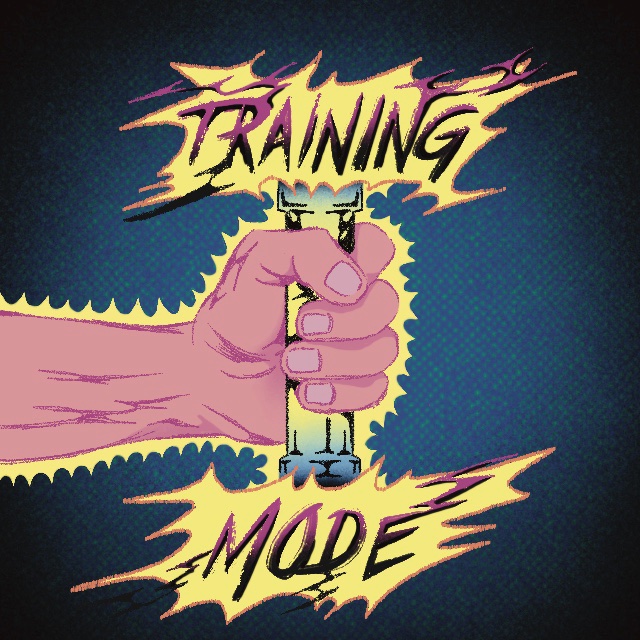If there’s one thing gaming and desk jobs have in common, it’s encouraging poor sitting posture. It’s practically an epidemic; so many of us are hunching forward for hours, staring at a bright screen, and putting severe stress on our spines. This leads to back soreness, spinal dysfunction, joint degeneration, unattractiveness, and other painful conditions.

Have you ever thought to yourself, I want to get better at games, but I don’t want to destroy my life? We’re here to help with a special week dedicated to all things video games and health.
Having sat with horrendous posture for years, I was really feeling these effects. In particular, I started experiencing severe discomfort and pain along my entire spine when laying on my back, like I had a tight knot in it. As I always slept curled up and spent my days hunched over a keyboard, my spine wasn’t used to me laying down flat! I also started to realize the consequences on my standing posture too. My head just seemed a little too far forward. It looked “off.” My neck muscles felt weak after years of leaning my head forward.
I decided I’d try to practice maintaining good posture while gaming, but I inevitably and subconsciously slipped back into a hunch. Drastic methods were necessary.
That’s how I discovered something I like to call “neck-xercise.” It’s exactly what it sounds like. Using your head’s weight, and slow, steady progression, you can strengthen your neck and keep it upright, with great posture, much more easily. If you’re interested in making some gamer gains, here are two great exercises.
The standard head raise
You can do this super simple exercise at home or at the gym.
All you need to do is find something flat and comfortable to lay on that allows your head to dangle off the edge. A bench or a firm bed works fine, but a gym bench would probably be the most convenient.
Laying on your back, with your head totally unsupported off of the edge, slowly lower it as far back as you are able, and then slowly raise it into a slight chin tuck. Repeat this as much as you are able, aiming for about 30 repetitions. Aim to do about three sets of as many as you can, under 30.
If you can do three sets of 30 with ease, with just your head weight, then you can add a small exercise weight. I recommend small increments of 0.25 pounds. We’ll discuss how to add and support this weight in a moment.
The face-down raise
We’ll be doing the same thing as before, but face down. We’re training the other side of the neck with this.
With your head positioned off the edge, slowly lower your head into a hanging position, then raise it back up into alignment with your body. Don’t try to raise your head back much farther. Normal standing alignment is what we’re going for. Try your best to reach three sets of 30 repetitions; these are high-volume, lightweight exercises.
Adding weight
When training your neck, it’s imperative to play it safe and take things slow. It’s important to remember that neck damage can have profound effects, but it’ll be fine if we relax and ease into things.
For the standard head raise, place a towel on your forehead. This is to create friction for keeping the weight secure and to act as a buffer from your forehead. Gently place the 0.25-pound weight on your forehead, and keep hold of it, slightly pulling it down against you. Maintain this grip and proceed with the exercise.
For the face-down raise, we’ll do a similar thing. Place the towel and weight on the back of your head, using your hands to keep the weight securely in place, and proceed as normal.
The benefits of neck-xercise
After doing this for a few days, I noticed that it became easier to support my own neck weight. This made it far less taxing to maintain good posture, even subconsciously, while gaming.
Some individuals also swear that developing a thicker neck though training can boost your physical attractiveness. I’ll leave you to form your own opinions, but it seems convincing enough.
In my own experience, other benefits include easing back tightness, as your posture habits improve, as well as an increase in general confidence in your ability to walk with your head up straight.
In terms of my posture, the improvement is night and day. I feel like I have a greater presence in the eyes of those around me. Hunched over, I had always felt a little invisible. Perhaps it’s purely mental, but confidence is mental! I also felt encouraged to take up more exercise gradually and improve my general fitness by starting slowly with neck training. Perhaps most importantly, my gaming habits are far healthier too, and playing for ages doesn’t stress my back anywhere near as badly as it did before.
At the very least, it’s worth a shot; then you can decide whether neck-xercise works for you!
- SEO Powered Content & PR Distribution. Get Amplified Today.
- Platoblockchain. Web3 Metaverse Intelligence. Knowledge Amplified. Access Here.
- Source: https://www.polygon.com/23547243/neck-exercises-for-back-pain-when-gaming
- a
- ability
- Able
- About
- Act
- After
- against
- Ages
- Aiming
- allows
- always
- and
- anywhere
- around
- back
- badly
- before
- benefits
- BEST
- Better
- body
- boost
- buffer
- call
- chin
- comfortable
- Common
- conditions
- confidence
- Consequences
- Convenient
- create
- day
- Days
- decided
- dedicated
- destroy
- developing
- DID
- discovered
- discuss
- Doesn’t
- doing
- Dont
- down
- easier
- easily
- easing
- Edge
- effects
- encouraged
- encouraging
- enough
- Entire
- Epidemic
- Even
- EVER
- exactly
- Exercise
- experience
- experiencing
- Eyes
- Face
- few
- Find
- fine
- Firm
- fitness
- flat
- form
- Forward
- friction
- from
- Gains
- Gamers
- Games
- gaming
- General
- get
- going
- good
- gradually
- great
- greater
- gym
- Hands
- head
- healthier
- help
- here
- hold
- Home
- HOURS
- How
- How To
- HTTPS
- I’LL
- imperative
- important
- improve
- improvement
- in
- include
- Increase
- individuals
- inevitably
- interested
- IT
- Jobs
- Keep
- keeping
- Leads
- Leave
- Life
- lightweight
- little
- looked
- made
- maintain
- Making
- many
- mental
- methods
- moment
- more
- most
- Near
- necessary
- Need
- night
- NIH
- normal
- ONE
- Opinions
- Other
- own
- Pain
- painful
- particular
- perhaps
- physical
- Place
- plato
- Plato Data Intelligence
- PlatoData
- Play
- playing
- Polygon
- poor
- position
- positioned
- pounds
- practically
- practice
- presence
- probably
- progression
- pulling
- purely
- Putting
- raise
- RE
- reach
- realize
- recommend
- remember
- repeat
- safe
- same
- Screen
- secure
- securely
- seemed
- seems
- Sets
- similar
- Simple
- Sitting
- slow
- Slowly
- small
- So
- some
- something
- special
- spent
- standard
- started
- Starting
- steady
- straight
- stress
- Super
- support
- Take
- terms
- The
- thing
- things
- thought
- three
- to
- too
- TOTALLY
- Training
- under
- under 30
- Upright
- us
- Video
- video games
- VOX
- week
- weight
- What
- whether
- while
- works
- worth
- would
- years
- Your
- yourself
- zephyrnet






